A Group of Anonymous Women Who Protest Racial and Gender Discrimination in the Arts Are Known as
Sexual politics is difficult terrain for young people to navigate. Desire, threat and insecurity are a powerful combination in the almost benign circumstances, fifty-fifty before teenagers were drenched in social media harassment and ubiquitous porn.
Outside the privileged cloister where we tested the limits, my generation of assertive young women were surprised to realise we represented a visceral threat to those men who chose to remain unmoved past the new politics that took the personal seriously.
The chilling reality of this confronted me non long afterward I arrived in Cairns in 1975, on the first leg of my journey to interview the bush poets scribbling away in Far North Queensland.
As I stood waiting for my brand new suitcase to appear on the luggage trolley towed from the plane, I fell into easy banter with a cowboy from central casting. He didn't offer to deport my luggage but followed me to the hire automobile desk. His insistent attending put me on alarm. I brushed him off, then made my style to the car park and onto the highway to town. Phew.
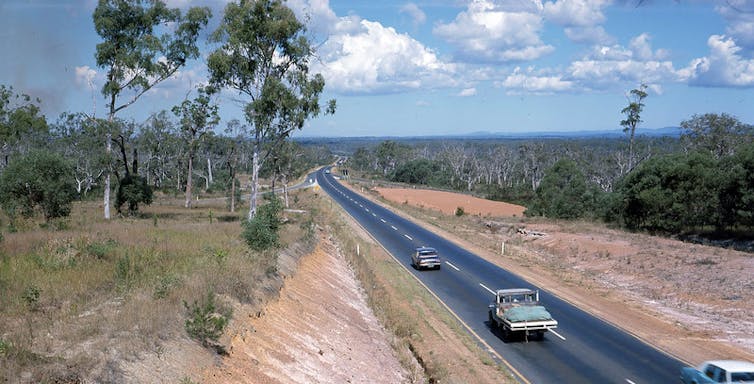
The threat had felt existent. I had absorbed the reports of the Bruce Highway horror stretch a piffling further south. Six unsolved murders in half-dozen years, and another two but months earlier. I locked all the doors of the little Mazda, wound the windows upwardly tight, and kept an center on the rear-vision mirror until I pulled into the motel, checked into my room and drew the curtains.
And so the cowboy's harassment actually started. Start a phone call, then a knock on the door, angry pacing outside the room, another call and banging on the window. I rang reception to complain and was told to go over it. No i was sent up the stairs to tell him to get lost or that they would call the constabulary.
The message was clear: women were fair game. Information technology seemed like hours before he gave upward. I was exhausted. In the morning, I gobbled the cardboard cereal and white toast pushed through the breakfast hatch, drank the pot of Robur tea, paid the beak and dashed to the car park. Then I locked myself in the car.
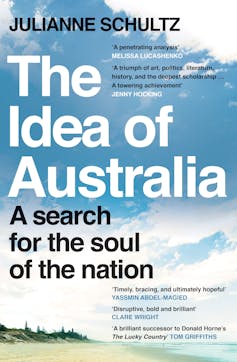
I was a bundle of nervous energy. It scarcely prodigal on the 60 minutes-long journey through the stifling heat of the pre–wet season, down the palm-fringed tropical declension to Innisfail. I was besides afraid to finish, though I badly wanted to have a swim, even in crocodile- and stinger-infested waters. I worried that if I did, the angry cowboy – or some of his mates – might reappear. I had read plenty paper reports to know that young women disappeared on remote country roads.
There was zilch infrequent nigh my experience. Anybody I knew had a similar story, or worse. The legacy of a violent frontier could not be wished away and did not just evaporate. Information technology echoed through the generations, finding new targets. Modern Queensland was notwithstanding pumped up with the testosterone-fuelled aggression that had marked its founding.
After I returned from my road trip, a friend told me she had seen cruel violence against women in some towns in Far North Queensland – assaults that were organised and condoned, the perpetrators beyond the reach of the law.
Information technology was, we would now say, structural. Non only a few bad eggs, but a system that treated young women every bit chattels. In her boondocks, not far from my uncomfortable feel, gangs of men and boys routinely identified a female target at a public event and enticed her outside. They chosen the gang rape a "railroad train" and convinced themselves, and the police, that the woman was "asking for information technology". The traumatised victims were rarely believed, the legal system seemingly designed to humiliate, shame and silence them.
When nosotros helped journalists from the National Times with the research they needed to travel to the boondocks and report what was going on, an ancient mechanism of control in new garb was fully revealed.
Within no time at all, similar stories bubbled up out of other land towns. After the horror of these organised attacks was reported, the entrada to ensure that the victims of sexual attack were treated with respect in Queensland gained new momentum. One of the but two women in the country parliament made it an issue.
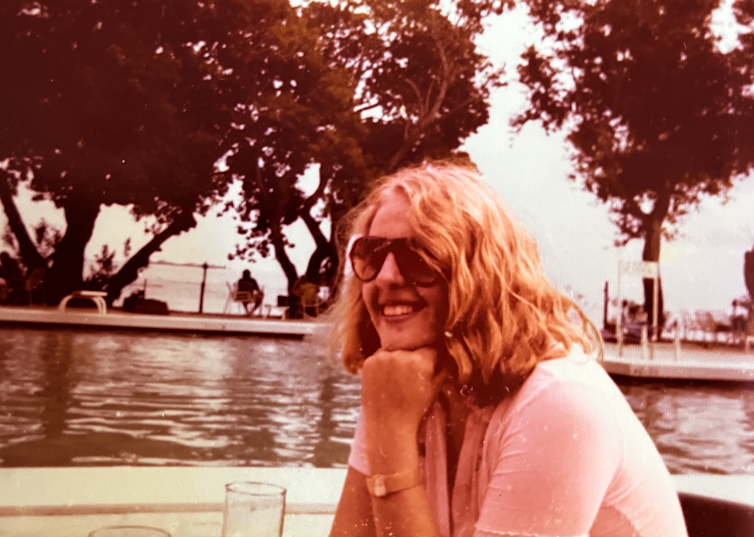
Rosemary Kyburz was a Liberal MP who would practise all she could to ensure these assaults did not go unpunished. Within a couple of years, the police inverse a footling.
Inquiries, reports, submissions and debates followed, and changes continued to be fabricated for decades equally the legacy of embedded misogyny revealed itself over and over. Sexual abuse could no longer be dismissed with the mocking laugh that had in one case accompanied it.
Nevertheless, nigh 50 years on, the police still works against female victims. The suppressed anger that many women carry outburst to the surface of public life when some other generation of young women, led by Grace Tame, Brittany Higgins and Chanel Contos, declared Plenty is plenty.
Baca juga: Making modify, making history, making dissonance: Brittany Higgins and Grace Tame at the National Printing Club
A few weeks after International Women'southward Day 2021, in cities and towns around Commonwealth of australia, women and men, many who hadn't marched for decades, took to the streets in response to the revelations of sexual abuse in Parliament House. The echo of past protests reverberated around the nation. It had non taken long for the 800,000 women who had been added to the balloter whorl in 1903 to go a wellspring of conservative votes for decades, but the polls suggested they would be no longer.
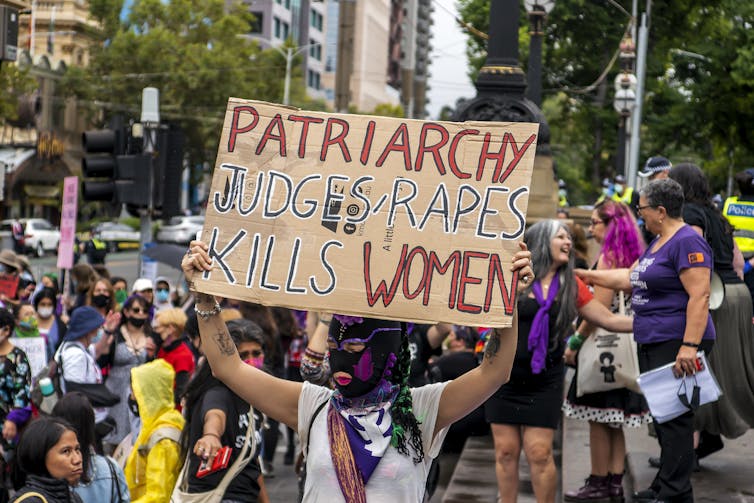
A right, non a souvenir
The animative idea of the women'due south movement – that equality was a right, non a gift or a political deal – transformed interpersonal relations, and crept into workplaces and schools. Language changed, expectations were recalibrated, and before long, behaviour followed. Simply it did not happen overnight and did non happen without a struggle. The ban on married women working in the public service had been lifted only two years before I started loftier school.
At that time, women were still the exception in the professions, paid one-third less than men and denied access to superannuation. In 1973, a few million dollars was made available past the federal regime for the first time to support childcare and some support for women's refuges followed. It was tiny past today's standards merely it transformed lives.
Iv years after, the editor of the Courier-Mail drew my showtime serious job interview to a halt: "What it is with y'all girls, why practice you all want to be journalists, what's wrong with teaching and nursing?" I didn't bother to plough up for the 2nd interview after the editor of the Gold Coast Bulletin, which still featured women in bikinis on the forepart folio, said, "If you lot're a pretty girl, come up on downward; if non, don't bother."
Soon the patter became more sophisticated. As Max Walsh, the editor at the Australian Financial Review, had told me at my task interview – in a pub – women would piece of work twice as hard for one-half the money as men, and he thought they'd be more able to extract secrets from businessmen than male journalists.
A few years later, in the early 1980s, when I was armed with a clipping-volume full of front end-folio stories and some experience in tv set, the head of current affairs at ABC TV baited me for an hour before dismissing me, request, "What makes you lot recall yous are pretty enough to exist on television?" Belittling and shaming were nevertheless fix tools of choice to put women in their identify.
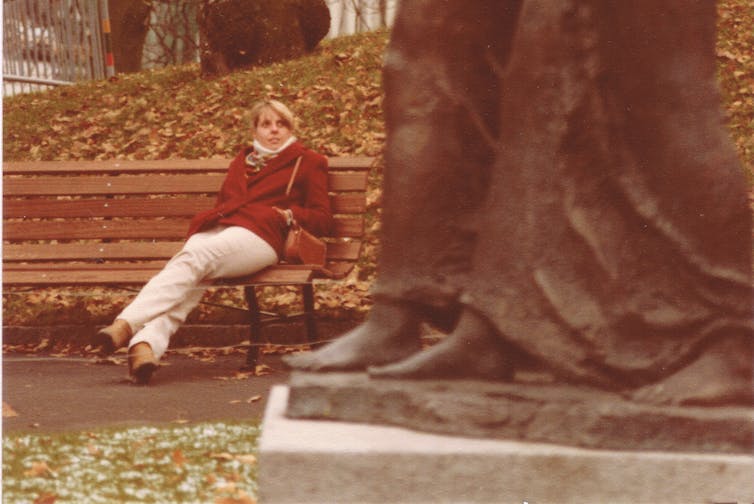
The yr before my experience at the ABC's Gore Loma headquarters, the High Court had ruled that Ansett Airlines could not discriminate against a adult female who was otherwise qualified to be a pilot. I had reported on Deborah Wardley's case for years as her prospective employer invented one excuse after another to block her – women weren't strong enough; unions would object; menstrual cycles, pregnancy and childbirth would jeopardise safety and increase costs. The court ruled on technicalities, not on principle.
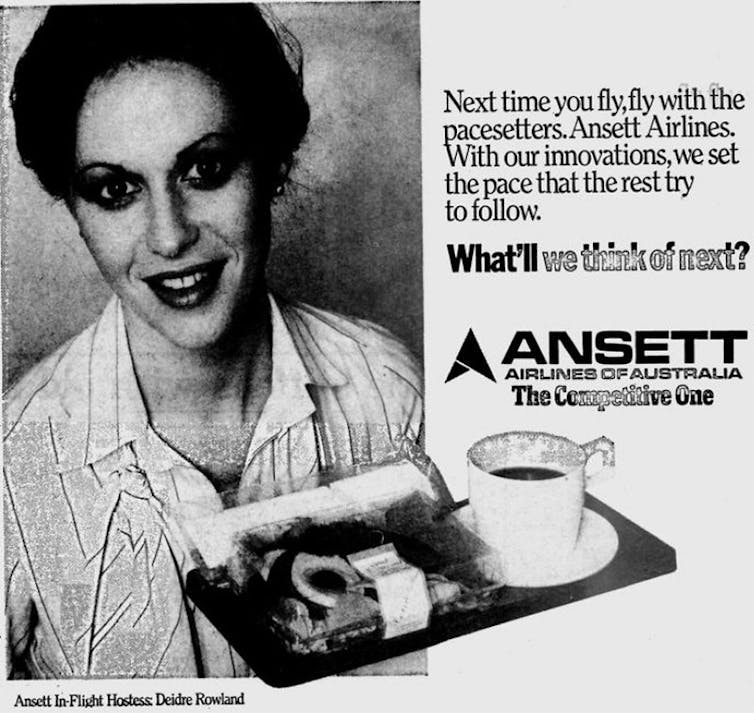
When a group of older mentors urged me to make a complaint virtually my treatment at the ABC, the cost seemed higher than any possible reward. I kept my notes and moved on; revenge, equally they say, is a dish best served cold.
It took until 1983 for Australia to sign the 1979 United nations convention designed to eliminate all forms of discrimination confronting women. Legislation followed in 1984, only its chief proponent, the Labor senator Susan Ryan, was subjected to bitter personal and public attacks.
At the big rallies in Canberra, anxious and angry Women Who Want to be Women pushed to the front to protest the changes. Some lxxx,000 people signed petitions opposing the relatively modest sex discrimination bill. Although key Liberal leaders supported it, the right wing of the party was bitterly opposed. It marked the start of a split that would dog the party for decades.
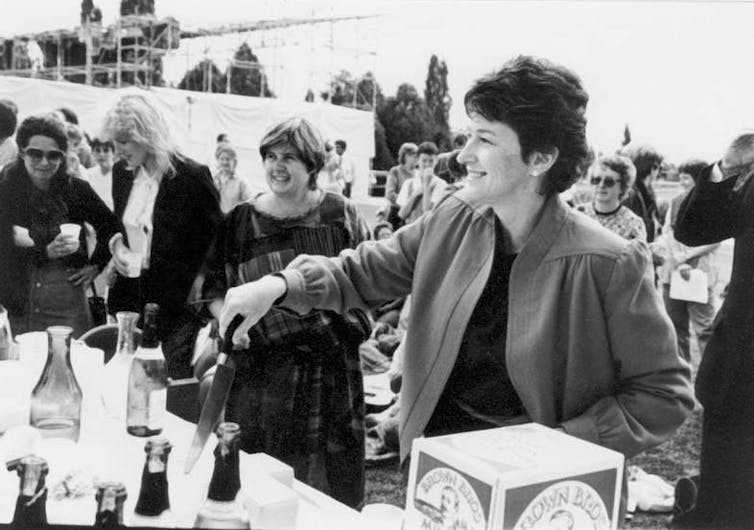
Baca juga: Friday essay: Sex, power and anger — a history of feminist protests in Australia
Susan Ryan was a feisty campaigner, and so the vicious onslaughts only increased her resolve. Women'due south rights were on the manner to becoming human rights, talent was no longer sifted by sex, merely the extent of the opposition stunned her.
The Australian legislation passed with the support of some Liberal members of parliament who defied their party and crossed the floor to vote with the regime.
Women did not have a secure footing in the ascendant party, every bit deputy Liberal leader and foreign minister Julie Bishop and Liberal MP Julia Banks found in the internal political party confrontation that ousted Malcolm Turnbull and replaced him with Scott Morrison. As Julia Banks declared in the House of Representatives, every bit she prepared to leave in 2018,
Often when good women call out or are subjected to bad behaviours, the reprisals, backlash and commentary portrays them as the bad ones: the liar, the troublemaker, the emotionally unstable or weak, or someone who should be silenced.
"Tell the states the story again about the paper chore interview in the pub," my teenaged daughter and her friends would say, at the turn of the century, each time nosotros drove downwardly Broadway past the old Fairfax building towards Sydney Academy. "Can you believe it?" the girls would chuckle.
Then they too entered the workforce and realised that the more subtle but wearisome paw of sexual bigotry was still doing its evil work, at present hidden behind laws and lofty rhetoric. Change rarely proceeds in a linear manner, simply the trend was clear.
Baca juga: The 'madness' of Julia Banks — why narratives about 'hysterical' women are then toxic
Assertive women, brutal political attacks
When Wayne Goss appointed Canadian-built-in Leneen Forde as Queensland'south governor in 1992, she was just the second woman governor in Australian history. She had fallen in dear with the son of former Australian prime minister Frank Forde and, like countless young brides, moved to Australia full of hope and expectation. She was shocked by what she discovered. Brisbane in the mid-1950s was a poor state town. The appliances she had taken for granted were considered luxury mod cons. A adult female's place was in the dwelling house. Just when her hubby died xi years later, this was no longer an choice for her.
With v young children to support, she began studying constabulary and five years subsequently her husband's death started work every bit a solicitor, somewhen condign the queen's representative in a land named for another.
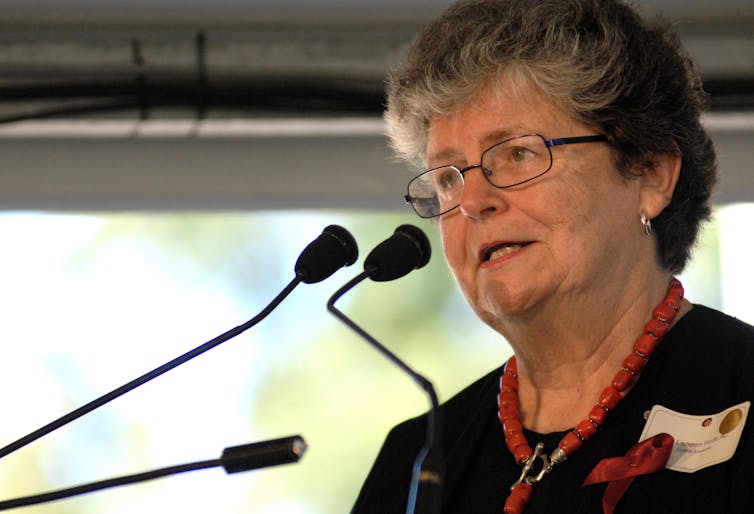
Queensland, despite the gender of its name, was a place where men prevailed and women were meant to know their place. Matt Foley challenged this when, as the state's attorney-full general, he decided that merit, not gender, would make up one's mind judicial appointments.
My former English teacher, Roslyn Atkinson, by then a distinguished barrister who had been the inaugural president of the Queensland Anti-Discrimination Tribunal and deputy chair of the state's Law Reform Commission, despite outraged protests from the former guard, became one of Foley's first Supreme Courtroom appointments in 1998.
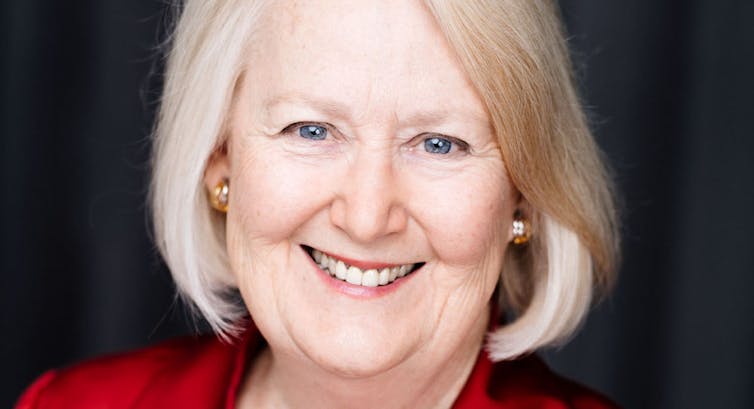
Within a few years, despite bitter heckling from those who were still convinced that "merit" meant "men", 7 of the land's 24 Supreme Court judges were women, and a woman was president of the Queensland Courtroom of Appeal. Years afterward it was still driving the press mad. The Courier-Mail would roll out manufactures anonymously reporting lawyers who knew women were just non up to it. These eminently well-qualified women were derided every bit "Matt's Girls".
In September 2015, Justice Catherine Holmes became the land'southward first female chief justice. This was a change that would non easily slide back. The reaction to these newly believing women was no less brutal in politics.
When Labor's Anna Bligh became the first popularly elected female premier in Commonwealth of australia in 2009, the misogyny that subsequently blighted Julia Gillard's prime ministership had an off-Broadway tryout in Brisbane. Bligh'southward resolute leadership during the 2011 floods, like Gillard's ability to navigate a hung parliament, counted for little. Her determination to privatise ports, roads, trains and coal terminals was not welcomed by traditional Labor voters. Spousal relationship-sponsored billboards on major thoroughfares mocked her, the printing despised her, and a brutal whispering entrada prevailed.

The 2012 election was a disaster for Labor: the party went from belongings 51 seats to seven. Balloter tides in Queensland are often more dramatic than normal swings on the carefully calibrated Australian electoral pendulum. It was a relatively short-lived win for the blokes who had felt they were born to run the state. It lasted just ane term.
A female person perspective
In 2020, the victorious Annastacia Palaszczuk became the first adult female to exist re-elected premier for a third fourth dimension. Under her assistants, women occupied an unprecedented number of positions of ability in what was once the most macho state. Information technology was a long way from the 1970s.
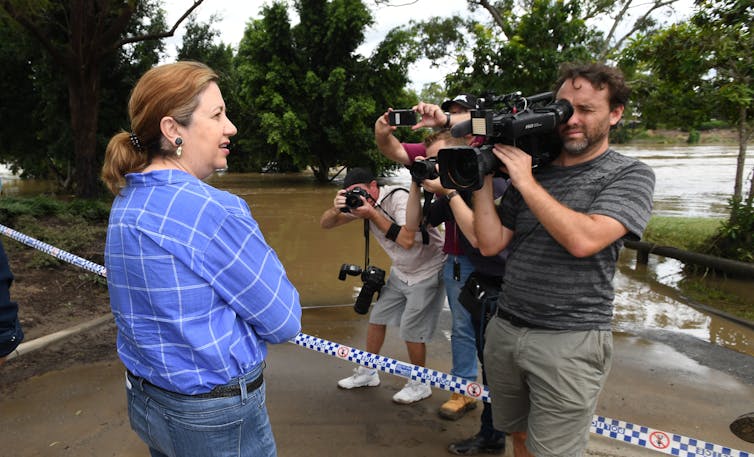
In 2021, most of the ministers in her cabinet were women, as were the governor, chief justice, police commissioner, chief medical officeholder, head of the Department of Premier and Cabinet, and six of the state's seven academy vice-chancellors.
Second-wave feminists had sometimes wondered, in the abstract, what would happen as occupations were dominated by women. Would that mean the profession had lost status? Was equality realised when mediocre women exercised as much accomplished power every bit mediocre men had always done?
But as Palaszczuk's legislation to innovate a Queensland bill of rights, legalise ballgame, outlaw coercive control, enable voluntary euthanasia and better define consent laws showed in a few short years, a female perspective could alter the calendar.
And information technology could drive some men mad. This was a profound cultural and political change that had nothing to do with detachment from the "mother country".
Baca juga: Friday essay: Our utopia ... careful what yous wish for
Mistake lines
Race and gender discrimination are inextricably linked and have long been defining Australian mistake lines. Female convicts – "whores", in the view of some commanders and male prisoners – were outnumbered at least three to one and were shared amidst the men in what Anne Summers has described as "imposed sexual slavery". But many were fiercely independent battlers who wanted a better life for themselves and their children and were prepared to claiming say-so.
Similarly, the Cammeraygal adult female Barangaroo, who became Bennelong'southward wife after her kickoff husband died from smallpox, gear up the bar loftier. She was an contained woman, a fierce hunter and provider who saw little reason to compromise with the new arrivals. She one time famously attended an official dinner at Government House in traditional garb, her naked body painted in white clay, a bone through her olfactory organ.
She died in 1790, and so was spared the distress of witnessing the fell and demeaning handling of her sisters and generations of others as the fight over the bodies of Aboriginal women became a recurring metaphor of settlement. Some formed loving relationships with settlers, others became leaders, simply many were treated as chattels, emotionally destroyed as their children were taken away, their men emasculated.
Commonwealth of australia was and is a securely male gild. For those with enough determination and a stiff sense of self-worth, frontier life encouraged a certain female fearlessness that is however evident.
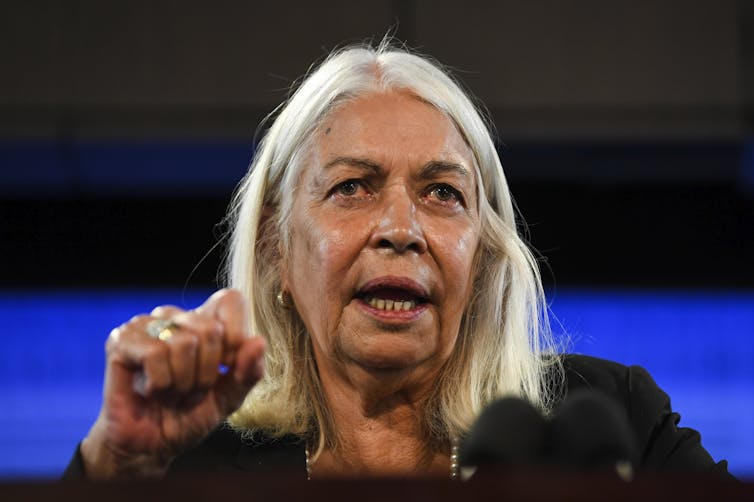
It is clear in the stars that polish abroad: writers and thinkers like Germaine Greer, Geraldine Brooks, Anne Summers and Kate Manne; scientists like the Nobel-winning Elizabeth Blackburn; actors similar Cate Blanchett, Nicole Kidman, Rachel Griffiths and Margot Robbie, who luminously make full the globe's screens; educators including Jill Ker Conway and Patricia Davidson; and anthropologists Genevieve Bong and Marcia Langton.
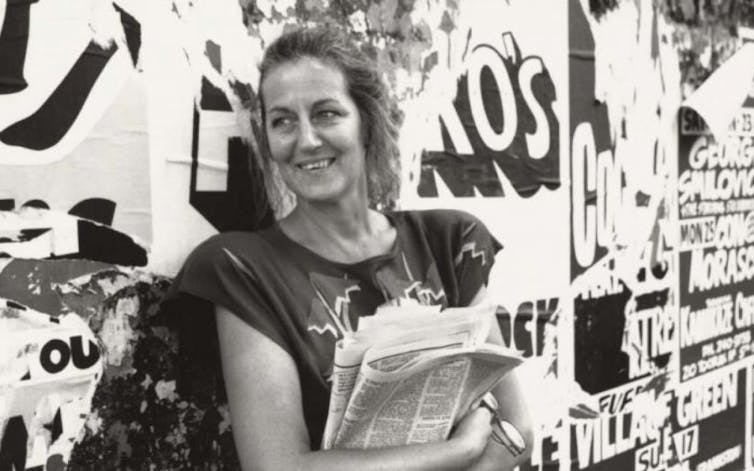
E'er since pastoralists recruited single men, not wanting to be encumbered past the boosted expense of providing for families, the political economic system of Australia has been built on the primacy of male person labour, male power and male command. The native-born and immigrant populations grew in the 19th century, simply it took the deaths of more than threescore,000 men in the offset world war for women to become the majority, although the generational loss reverberated for decades.
Women remained, in Anne Summers' famous phrase, either "damned whores or God's law". Sexualised taunting was and still is the boulder of corruption likely to rain downwards on Australian women who speak their mind, provide professional communication, demand more and expect R.E.Southward.P.E.C.T., as Aretha Franklin sang. Still, goose egg fires up the aroused Twitterati quite like women making otherwise unremarkable comments almost their rights and expectations.
'One of the well-nigh racist towns in the country'
The intersection of these discriminations was on proud, unapologetic brandish when, in 1977, I flew three hours west of Brisbane to Cunnamulla.
Peter Manning, and so the editor of Nation Review, had deputed me to report on a community that had been characterised as one of the most racist towns in the country for the independent newspaper. As I had learned from my weeks on the route talking to bush poets, travelling alone on this assignment would have been foolhardy, and so I accompanied two of my friends. Wayne Goss and Matt Foley were working for the Ancient Legal Service at the time, and they had a slate full of meetings and courtroom hearings.
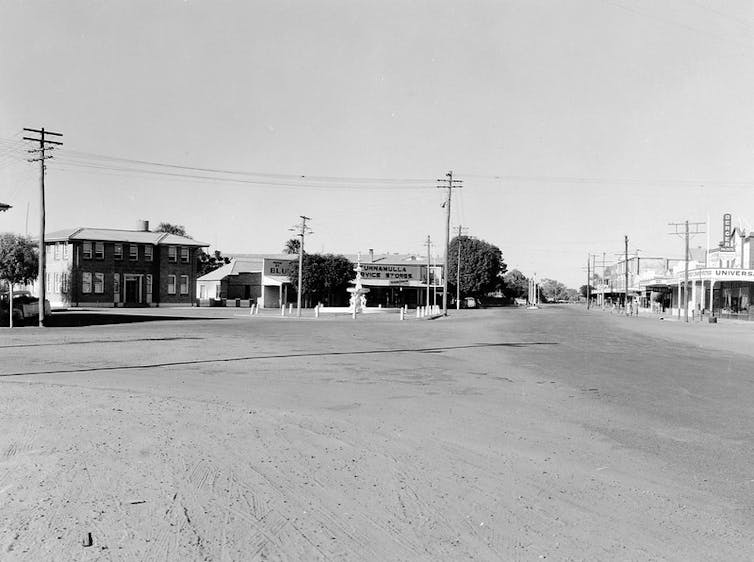
At the fourth dimension, Cunnamulla was home to 1500 people (about, according to the signpost), 7 pubs and seven draperies, and unemployment was officially running at 25%. 8 of every x Aboriginal people were without piece of work. It was a boondocks where grog ruled, dozens of children were malnourished, and the grief from scores of infant deaths each year was overwhelming.
As the plane touched down, the local man sitting next to me asked where I was staying. The Social club, I said. He spoke in the leering, patronising way I had come to expect in my travels through the land, setting the tone for the following week. As we left the airplane he reassured me that I would be safe: "They don't let the darkies into the Club Hotel."
Cunnamulla is ane of a handful of outback Australian towns that has a grim, larger-than-life reputation. Wilcannia, in the far west of New South Wales, which briefly won national attention during the pandemic, is another. Both towns had had their reputations unfairly tarnished, every bit the requests of their leaders were persistently ignored and dismissed. It has long been easy to ignore those who live beyond the Great Dividing Range.
Not long later William Landsborough described the potential of the country he observed around what became Cunnamulla – as he crossed the continent from north to due south in search of the ill-fated explorers Burke and Wills – the south-w of Queensland was rapidly divided into vast stations.
Squatters soon claimed the mulga-clad countryside and murderous incursions became the norm. Native Police force were stationed in the Cunnamulla township. Reports of the killings in the 1860s were so shocking that they provoked the Anglican bishop of Sydney to establish a mission. He had been outraged past a squatter's jape that if he had "known how useful they might exist he wouldn't have killed so many blackfellows".
Baca juga: How unearthing Queensland's 'native constabulary' camps gives us a window onto colonial violence
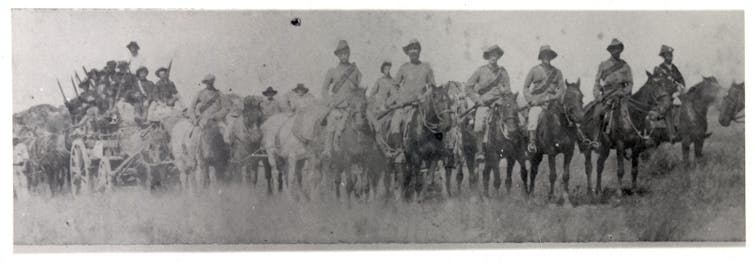
The unprepossessing settlement on the banks of the Warrego River nearly 800 kilometres due westward of Brisbane is an unlikely entry in the compendium of noteworthy places. Its murderous history was conveniently forgotten and replaced with a pastoral fantasy. Maybe the mouth-pleasing ring of the name helped. Henry Lawson thought it suggested pumpkin pies. He immortalised the Cobb & Co. coach stop in his story The Hypnotised Township, but described the town as a place of "troubled slumbers".
Years later the Aboriginal poet Herb Wharton, who was born near Cunnamulla, won international acclaim when he broke the hypnotic silence. He turned the settler stories on their heads and told the droving tales of Murri stockmen and women. He and his sister Hazel McKellar then recorded the tales of massacres, including the one their grandmother had survived.
Still, the "Cunnamulla Fella", who lived on damper and wallaby stew and was conjured by land singer Slim Dusty, is the figure who endures as a statue in the town. A selfie with the "Fella" is a tick on the roaming grey-nomad bucket list.
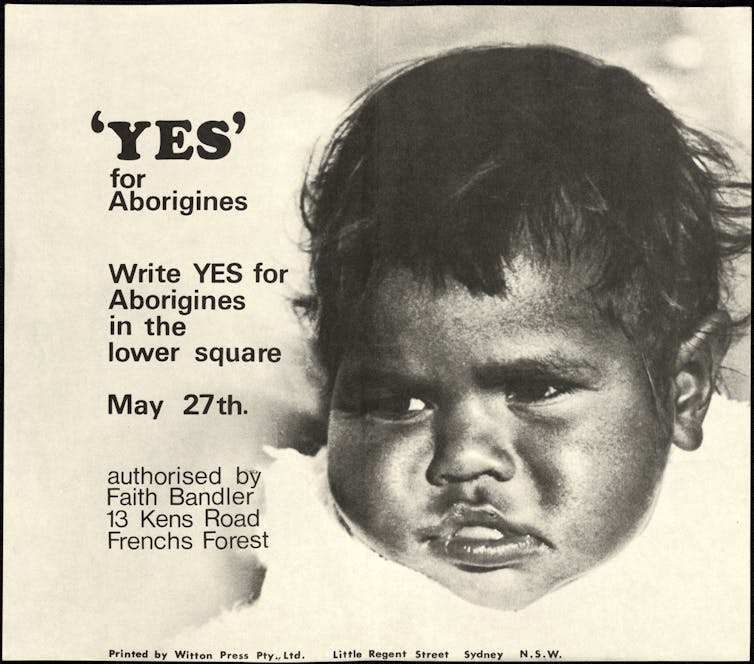
An ugly reality
Night histories haunt places and often recur in other uncanny manifestations. Some may consider the Cunnamulla Fella a mannerly artefact of a foretime age, but in that location was cipher mannerly about Out of Sight, Out of Mind, the depiction of the boondocks by ABC'due south Four Corners programme in 1969.
This film, circulate just 2 years after the referendum that brought Start Nations people into the mainstream, was one of those moments when current affairs television excelled. Information technology brought the shameful reality of life in fringe camps into middle-class loungerooms.
The pale, well-spoken journalist was doing a skilful job, but looked like a creature from another planet, dropped in to share his outrage. It was an excoriating portrayal of the wrongful conviction of an Aboriginal woman, and of the shocking conditions in the two boondocks camps that were habitation to descendants of the Kunja people who had once been shot and poisoned by graziers.
Audiences around the country reacted with fury. "I'm praying for [mayor] Jack Tonkin's soul in purgatory," ane wrote, "simply I don't like my chances." ABC management prohibited the sale of the programme to the BBC; the picture information technology painted was too ugly for international consumption.
The broadcast prompted an firsthand political response: money suddenly became available to build 26 fibro houses scattered through the boondocks. When I visited eight years later, the houses were congenital and simply the remnants of the camps remained. The community links that had given life in the settlement its own coherence had dissipated; drunkenness had become the subversive norm.
The angry racism that once fuelled the borderland wars even so had full-throated vocalism. Like so many outback towns, Cunnamulla seemed to be dying. "You take to blame it on something, what improve than the boongs," 1 angry newcomer told me.
Those I met on that short trip felt no demand to hide their fury. The media had destroyed their boondocks. "Nosotros were doing the correct affair by the blacks until Four Corners came along," i self-appointed spokesman berated me when I attended a dinner organised by the Rotary Club.
'I only want a fair go for the white fella'
The anger in the room bubbled up as they listened to social worker Matt Foley'south talk. When it came time for questions, the local solicitor chairing the meeting passed around handwritten notes: "tone it downwards", "no aggressive questions", "at-home down". The back and along continued until well after midnight. Then, like a tempest that had passed, the tone changed. "We're still friends, aren't we?" the man who had near aggressively blamed the media at the start of the evening asked equally he wandered off to his car. He should non take been driving.
In the forenoon a taxi driver who had been function of the aroused group the night before well-nigh ran me over and then demanded I go into his car for a tour of the camps and the new houses. He knew who to blame. Every bit we drove forth the uncurbed streets he pointed to one rundown firm later another:
Black house, white firm, black house … I promise y'all are going to give those bastards heaps … I merely want a fair go for the white fella.
In the previous six months there had been nearly 300 convictions for drunkenness: 163 Aboriginal men and 58 women; 55 white men and 2 women. "You can't live here without drinking," my not-so-friendly taxi driver alleged.
Four of the women I met stood out and take remained with me always since. I was the doctor's elderly receptionist. When I knocked, she answered the door to the surgery armed with a paper knife. "You learn to wait anything, and gear up yourself," she said as she put the blade in a drawer.
Another was a tough, damaged woman who owned 1 of the three pubs that served Ancient people. She had installed a metal cage along the bar. "I don't know why the blacks drink hither. I like them, merely I've lost control. I don't care how much I lose, I'm selling this place," she told me.
Exterior her pub a young woman, who looked at least xx years older than she was, grabbed my arm and repeated, over and over,
I'one thousand just a blackness mongrel bounder. I got no 1, I got nowhere to go, I'm only a blackness mongrel bastard.
Baca juga: Non-Ethnic Australians shouldn't fear a First Nations Voice to Parliament
Hazel McKellar's reforming free energy
The most outstanding person in the boondocks was Hazel McKellar. She was the antithesis of what Bernard Smith would later describe every bit the "tragic muse" of Australian arts, the "old Aboriginal woman surviving precariously as a fringe dweller in some unknown country town". She was a handsome, intelligent woman who, since returning to Cunnamulla after working equally a housemaid on stations, had devoted herself to holding her community together equally external and internal forces conspired to pull it apart.
Even in progressive circles, the prevailing paradigm of Aboriginal people in the late 1970s was as victims – people with little agency or authorization, people who had been damaged or destroyed.
Hazel McKellar did not fit this stereotype. She had big ideas and was prepared to pull any levers she could to realise them. She wanted a different school curriculum then children could larn nearly their civilisation, something the local school's principal thought "might be helpful for boring learners".
Two-thirds of the 440 students at the principal school were Aboriginal, but the experience of their forebears was not evident in the curriculum. In Yr 5 social studies, as the chief helpfully explained, "Nosotros teach the kiddies nigh explorers and the opening up of Australia."
Hazel McKellar'southward advocacy for including cultural noesis was ahead of the zeitgeist. Within a few years she was writing books that captured this cognition. Her brother Herb Wharton had put the old brigade on notice through his poetry, which they celebrated; they may not have liked what he said, only they understood his language.
During those intense few days in 1977, Hazel and I talked about the immediate past, but not the longer past that had shaped information technology. Her focus was on the future. She campaigned relentlessly for improvements to health, housing and instruction, and for a cultural and community heart.
"It's the little things that niggle, like knowing there is only 1 white family in town whose kids will come to an Ancient child's party," she told me.
I've just learnt to not become where I am not wanted. It used to brand me aroused, and I still resent it at times, but you have to accept it, I approximate. Simply it'due south only us who are keeping this identify going.
'Settled in the Dreamtime'
By 2019, the map of s-west Queensland was closer to what it would have looked similar about 170 years earlier, when Thomas Mitchell had swept through the region identifying land suitable for cattle. The aeriform view of the region from the National Native Title Tribunal's map now shows a vast patchwork of native title lands, and many places of significant cultural heritage. To the west and due south of Cunnamulla, 200,000 square kilometres of land has been returned to traditional owners.
When Hazel McKellar told me in 1977 that it was just her people who would proceed the surface area going, neither of usa could have predictable this transformation. By 2021, the sign at the entrance declared Cunnamulla a "Heritage Town", "Settled in the Dreamtime".
The aboriginal stories of the state and its people, in one case a crusade of such embarrassment and shame, had go a source of pride and inspiration. Bearding trolls may rage on Twitter, just no i would say out loud the things that they had once said to me, notebook in hand, spellchecking names as I jotted down their comments.
Alexis Wright is a Waanyi woman who grew upwardly in Cloncurry, more 1000 kilometres n-west of Cunnamulla, at the other end of the Channel Country that regulates the cycles of life in the vast inland. It is the boondocks where Scott Morrison tramped through the cemetery looking for his slap-up-great-aunt Dame Mary Gilmore'south graveyard.
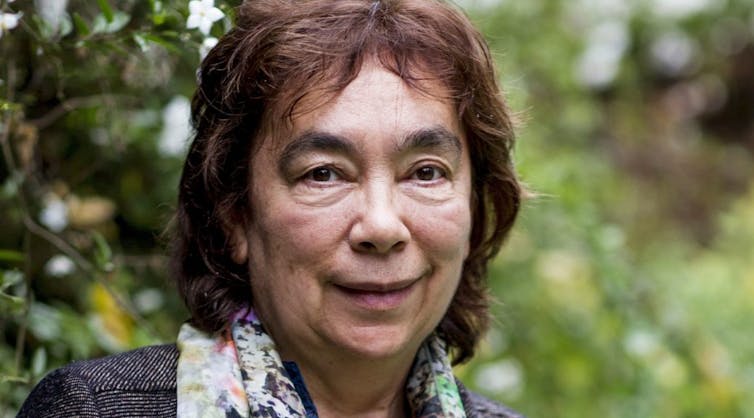
In 2007, Wright became the second First Nations writer to win the Miles Franklin Literary Honor for her magisterial novel Carpentaria, then won the Queensland Premier's Literary Award for fiction – the outset Aboriginal author to do so. It was recognition that would accept been inconceivable xxx years earlier.
The celebration of her remarkable book was, inevitably, tinged by politics. On the eve of her win in June 2007, the Howard regime launched its Northern Territory Intervention, when troops and public servants were sent into remote First Nations communities. The softly spoken author was asked about the intervention and replied with passionate denunciation: there were real problems of abuse in some communities, but a unilateral intervention without consultation could non be the solution.
Baca juga: X years on, it's fourth dimension we learned the lessons from the failed Northern Territory Intervention
The gestation of Carpentaria had taken many years, as Wright had tried to bring to the page the stories and ways of existence she had heard from the former people. Every major publisher rejected the opus earlier Ivor Indyk at Giramondo Printing recognised the novel's unique brilliance.
In an astonishingly original way, Wright tells hitherto invisible stories and captures the spirit of a different mode of storytelling. Her stories wove dorsum on themselves, rich with magic, symbolism, grit and determination; they turned time and place and the conventions of English literature within out and fabricated her a contender for the Nobel Prize for Literature.
The profound change embodied in the accolades she continues to receive, and the insights she shares virtually the idea of Australia, have very little to exercise with anxiety about detachment from Britain. Her novels, like many others, better respond the question Who are we? than any politician has for decades. As has happened before and will happen again, past making the political personal and turning information technology into civilization, Wright encourages a new, fit-for-purpose understanding to emerge.
Culture changes
In 1890, another Queensland novelist, Arthur Vogan, wrote The Black Police almost the massacres in the country'southward Channel Country and his shocked reactions to the way they were applauded by settlers.
Information technology was a surprising popular success. Although local newspapers bristled with reports of deaths from incursions, it was a contentious subject, and i that fabricated for a challenging novel. The critics were scathing, merely it struck a nerve and was reprinted several times.
Arthur Vogan lost his task as a announcer, just as Carl Feilberg had done a decade earlier following his entrada confronting the Native Police in The Queenslander. Similar Feilberg, Vogan also realised he was on a blacklist and had to get out. He moved as far away as he could—to Perth—and gave upwards writing for some time.
He was one of many authors punished for writing an "anti-Australian" novel. This was a smear that would be spread thickly for decades.
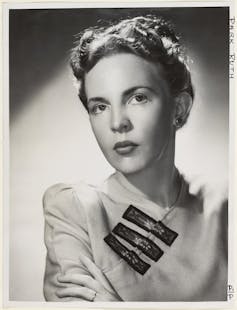
In 1947, Ruth Park was subjected to an organised entrada of threats and vilification for the life she portrayed in Surry Hills in The Harp in the Due south, which had won a competition run by the Sydney Morning Herald. Subscription cancellations and letters poured in to the editor, all asking unlike versions of the aforementioned question: "Why should Australia, with all her beauty to choose from, have to go to the sewer for her literature?"
Ruth Park besides retreated. She left the country amid a chorus of criticism and only returned years later. Now her novels are on school reading lists, Wikipedia lists the dozens of prizes she won, and in 2006 she was recognised in The Message'southward list of the hundred well-nigh influential Australians. Civilization changes, and equally it does, once unpalatable truths can be said out loud and challenge and right sick-informed angry outbursts.
This is an edited extract from The Idea of Commonwealth of australia by Julianne Schultz (Allen & Unwin)
Julianne Schultz will talk about The Idea of Australia, in conversation with Peter Mares, at ACMI on Fri 11 March at 6pm. Free, bookings required. The event will exist livestreamed online via ACMI'south YouTube channel. She will also exist speaking at various events
Source: https://theconversation.com/friday-essay-fair-game-racial-shame-and-the-women-who-demanded-more-176256
0 Response to "A Group of Anonymous Women Who Protest Racial and Gender Discrimination in the Arts Are Known as"
Post a Comment